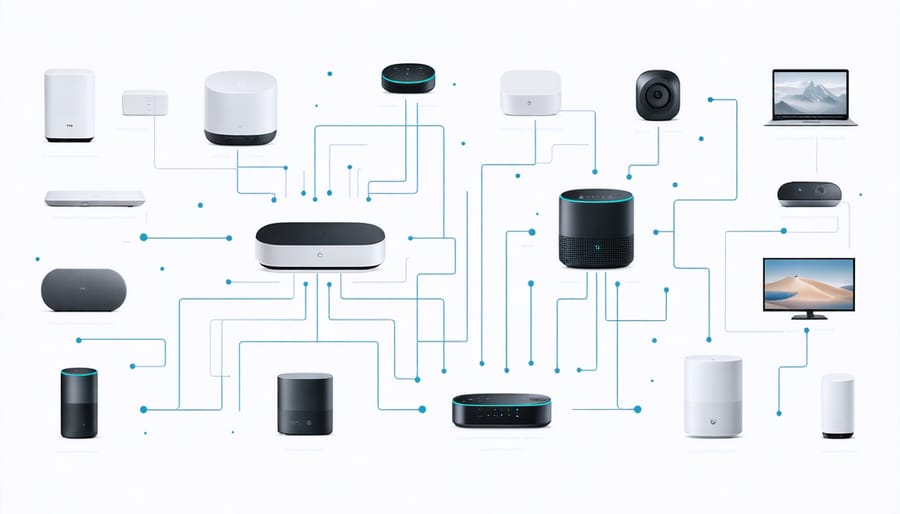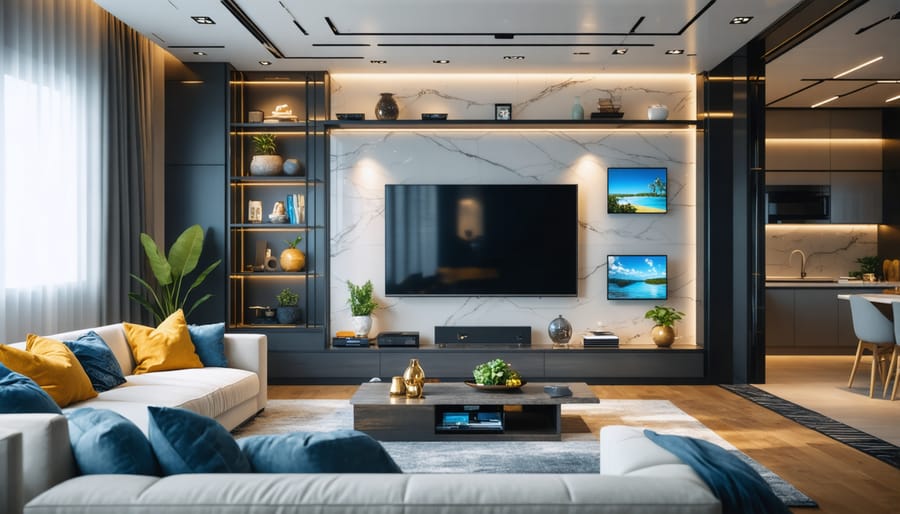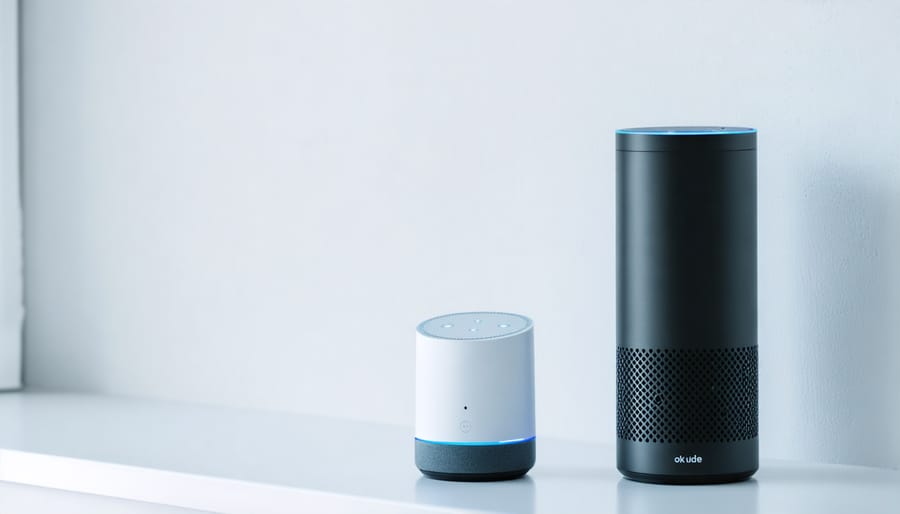Transform your living space into an automated sanctuary with today’s accessible smart home technology. Home automation isn’t just about convenience—it’s about creating an intelligent environment that anticipates your needs and enhances your daily routines. In this comprehensive tutorial, we’ll walk you through the essential steps of interior automation, from selecting compatible devices to programming sophisticated scenes that make your home work seamlessly for you. Whether you’re starting with basic smart lighting or ready to orchestrate a fully integrated system, this guide will help you transform your living space into a modern, efficient haven that responds to your lifestyle. Learn how to coordinate multiple devices, set up automation schedules, and create personalized scenarios that bring comfort, security, and energy efficiency to every room in your home.
Getting Started: Your Home Automation Foundation
Smart Hub Selection
Selecting the right smart hub is crucial for creating a seamless automated home experience. As the foundation of your smart home systems, your hub choice will determine which devices you can integrate and how smoothly they’ll work together.
Popular options like Samsung SmartThings, Apple HomeKit, and Amazon Alexa each offer unique benefits. SmartThings provides excellent third-party device compatibility, while HomeKit emphasizes security and seamless iOS integration. Alexa stands out for its voice control capabilities and extensive skill library.
Before making your choice, consider these key factors:
– Device compatibility with your existing or planned smart products
– Your preferred ecosystem (iOS, Android, or platform-agnostic)
– Local vs. cloud processing preferences
– Voice assistant integration needs
– Budget constraints
For beginners, we recommend starting with user-friendly hubs like Google Home or Amazon Alexa. These platforms offer straightforward setup processes and broad device support. More tech-savvy users might prefer advanced options like Home Assistant, which provides greater customization but requires more technical knowledge.

WiFi and Network Setup
A reliable WiFi network is the backbone of any smart home system. Start by ensuring your router is centrally located and elevated to maximize coverage throughout your home. For optimal performance, choose a dual-band router that supports both 2.4GHz and 5GHz frequencies – most smart devices work better on 2.4GHz due to its superior range and wall penetration.
Create a dedicated network name (SSID) for your smart devices to keep them separate from your personal devices. This not only improves security but also makes troubleshooting easier. Make sure to use WPA3 encryption if available, or at minimum WPA2, and create a strong password.
If you have a larger home, consider adding WiFi mesh extenders to eliminate dead zones. Position these strategically in areas where your smart devices need consistent connectivity. For bandwidth-heavy devices like security cameras, try to keep them within direct line of sight of your router or mesh points.
Remember to regularly update your router’s firmware and maintain a list of all connected devices for easy network management. Keep your network password secure and change it periodically for enhanced protection.
Essential Smart Home Zones
Living Room Automation
The living room is the heart of your home, and automating it can transform your daily experience. Let’s explore how to create a smart living space that responds to your needs effortlessly.
Start with smart lighting, which forms the foundation of living room automation. Install smart bulbs or switches that allow you to control brightness and color temperature through your smartphone or voice commands. Create lighting scenes for different activities – bright lights for cleaning, warm dimmed lighting for movie nights, and gentle evening modes for relaxing.
For entertainment systems, consider a smart TV hub that integrates with your other devices. Connect your streaming services, gaming consoles, and sound system to a central control point. Modern smart remotes or phone apps can replace multiple controllers, simplifying your entertainment setup. Add motion sensors to automatically pause media when you leave the room and resume when you return.
Climate control is crucial for comfort. A smart thermostat learns your preferences and adjusts automatically throughout the day. Install smart blinds or curtains that respond to sunlight and temperature, helping maintain optimal room conditions while saving energy. These can be programmed to open gradually in the morning and close at sunset.
Tie everything together with a smart home hub that enables coordinated “scenes.” For example, saying “Movie Time” could dim the lights, lower the blinds, turn on the TV, and adjust the temperature to your preferred setting. Morning routines might gradually brighten lights and raise blinds while turning on your favorite news channel.
Remember to place sensors strategically and ensure your Wi-Fi network is strong enough to handle multiple connected devices. Start with basic automations and gradually add more sophisticated features as you become comfortable with the system.

Kitchen and Dining Area
Transform your kitchen and dining area into a culinary command center with modern smart kitchen automation solutions. Start with a smart refrigerator that tracks your groceries and suggests recipes based on available ingredients. Install voice-controlled faucets for hands-free operation while cooking, and add motion-sensor under-cabinet lighting to illuminate your workspace automatically.
Smart ovens and cooktops are game-changers for busy households. Program cooking times and temperatures remotely through your smartphone, receive notifications when your food is ready, and even get alerts if you’ve left the stove on. Consider installing a smart coffee maker that begins brewing before you wake up, scheduled through your home automation system.
In the dining area, automated lighting scenes can create the perfect ambiance for different occasions. Set up motion sensors to illuminate the space when someone enters and dim the lights automatically during dinner time. Smart plugs can control small appliances like wine coolers and warming drawers, integrating them into your home automation ecosystem.
For ultimate convenience, implement a voice-controlled assistant to manage your kitchen tasks. Ask for recipe instructions, set multiple timers, or add items to your shopping list while your hands are busy cooking. Install smart smoke detectors that not only alert you but can automatically shut off compatible appliances if they detect danger.
Remember to group your kitchen devices logically in your home automation app, creating routines like “Morning Coffee,” “Dinner Time,” or “Clean Up” for seamless control of multiple appliances and features with a single command.
Bedroom Smart Setup
Transform your bedroom into a sleep sanctuary with smart automation that optimizes both your evenings and mornings. Start with smart lighting – install color-changing bulbs that automatically dim in the evening to help trigger your body’s natural sleep response. Program these lights to gradually brighten in the morning, mimicking sunrise for a more natural wake-up experience.
Consider adding smart blinds or curtains that can be scheduled to open and close at specific times. This helps regulate natural light exposure and maintains privacy while creating the perfect sleep environment. Pair these with a smart thermostat to automatically adjust your bedroom temperature – studies suggest that slightly cooler temperatures (around 65-68°F) promote better sleep.
For ultimate convenience, set up a bedtime routine that triggers multiple actions with a single command. Say “Good night” to your smart assistant, and watch as it dims the lights, closes the blinds, adjusts the temperature, and even plays soft white noise or relaxing music through smart speakers.
Morning routines can be equally seamless. Program your smart devices to coordinate wake-up times with your schedule. Your blinds can open gradually, lights can brighten, and your smart speaker can start playing your favorite morning playlist or news briefing. Add a smart coffee maker to your network, and wake up to the aroma of fresh coffee without lifting a finger.
Don’t forget about air quality – a smart air purifier can maintain optimal breathing conditions throughout the night, while a connected humidifier adjusts moisture levels automatically. For deeper sleep insights, consider integrating a smart mattress or sleep tracker that monitors your sleep patterns and adjusts your environment accordingly.
Remember to keep your setup simple at first and gradually add features as you become comfortable with the basics. This approach ensures you’ll create a truly personalized sleep environment that enhances both your rest and your morning routine.
Creating Smart Scenes and Routines
Morning Wake-Up Scene
Start your day right with an automated morning routine that transforms your home into a welcoming space as you wake up. Imagine your blinds gradually opening to welcome natural sunlight, your favorite playlist softly playing through smart speakers, and your coffee maker brewing your perfect cup – all without lifting a finger.
To set up your morning wake-up scene, begin by connecting your smart devices through a central hub like SmartThings or Home Assistant. Program your routine to trigger at your desired wake-up time, or sync it with your smart alarm. Consider incorporating energy-efficient smart routines by programming your thermostat to gradually warm up the room before you wake.
Layer your automation with gentle transitions: start with subtle lighting at 10% brightness, gradually increasing over 15 minutes. Add smart plugs to your bedside lamp or air purifier for additional ambiance. For the perfect morning atmosphere, set your smart blinds to open slowly, mimicking a natural sunrise.
Don’t forget the practical elements – program your bathroom lights to activate at a warm color temperature, and schedule your smart mirror to display the day’s weather and calendar events. With these automated touches, you’ll create a morning routine that feels both luxurious and effortless, helping you start each day on the right note.

Evening Relaxation Mode
Transform your evening routine into a seamless experience with automated comfort settings that help you unwind after a long day. As the sun sets, your home can automatically transition into relaxation mode, creating the perfect atmosphere for winding down.
Start by programming your smart lights to gradually dim and shift to warmer tones around your preferred bedtime. Set your thermostats to adjust to your ideal sleeping temperature – typically between 65-68°F (18-20°C) for optimal rest. Configure your automated blinds or curtains to close, ensuring privacy and blocking out street lights.
Create a calming ambiance by setting up your smart speaker to play soft background music or white noise at a low volume. Program your TV and entertainment systems to automatically power down at a specific time, helping you maintain healthy sleep habits.
For added security and peace of mind, set your home security system to “night mode,” which can include activating exterior lights, ensuring all doors are locked, and arming security cameras. Consider adding motion-sensor night lights in hallways and bathrooms for safe navigation during late-night visits.
Pro tip: Create different evening modes for weekdays and weekends to accommodate varying schedules. You can also set up voice commands like “Good night” to trigger your entire evening sequence at once, making it even more convenient to settle in for the night.
Voice Control Integration

Voice Assistant Selection
Selecting the right voice assistant is crucial for creating a seamless automated home experience. The most popular options include Amazon Alexa, Google Assistant, and Apple’s Siri, each offering unique advantages for your smart home setup.
Amazon Alexa stands out for its extensive device compatibility and straightforward setup process. It’s particularly effective for beginners and offers a wide range of skills that can be customized to your needs. Google Assistant excels in natural language processing and integration with Google services, making it ideal if you’re already invested in the Google ecosystem.
For Apple users, Siri through HomeKit provides excellent voice control accessibility and superior privacy features, though it may have fewer compatible devices compared to its competitors.
When setting up your chosen assistant, place the smart speaker in a central location with minimal obstacles. Consider having multiple speakers for larger spaces to ensure consistent coverage. Remember to customize wake words, create routines, and set up voice profiles for different family members to maximize the effectiveness of your voice control system.
Remember that you’re not limited to using just one assistant – many smart homes successfully integrate multiple platforms to leverage the best features of each system.
Custom Voice Commands
Customizing voice commands adds a personal touch to your home automation system while making it more intuitive to use. Start by identifying the phrases that feel most natural to you – instead of saying “turn on living room lights,” you might prefer “illuminate the living room” or simply “lights on living room.”
Most smart home hubs allow you to create custom voice commands through their companion apps. To set up a new command, navigate to your voice assistant’s settings and look for options like “routines” or “custom commands.” Here, you can pair your preferred phrase with specific actions.
Consider creating multi-action commands that feel conversational. For example, “movie time” could dim the lights, lower the blinds, and turn on your TV. Or “good morning” might gradually brighten the lights, raise the blinds, and start your coffee maker.
Pro tip: Keep your custom commands simple and memorable. Avoid complex phrases that are hard to remember or pronounce. Test your commands with family members to ensure they’re intuitive for everyone in the household.
Remember to update your custom commands periodically as your needs change and you add new devices to your system.
Troubleshooting and Maintenance
Even the most well-designed smart home systems can encounter hiccups from time to time. Here’s your guide to solving common issues and keeping your automated interior running smoothly.
First, if devices aren’t responding, start with the basics: check your WiFi connection and ensure all devices are properly powered. Sometimes, simply restarting your router or hub can resolve connectivity issues. If problems persist, try removing and re-adding the problematic device to your network.
Battery-operated devices like sensors and smart locks require regular maintenance. Set calendar reminders to check batteries every three months, and keep spare batteries on hand. For optimal performance, clean sensors and camera lenses monthly with a soft, dry cloth.
Voice assistants occasionally become unresponsive or misinterpret commands. Try rephrasing your commands using simpler language, and regularly update your voice command list to remove any conflicting automations. If needed, retrain your voice assistant to better recognize your speech patterns.
App-related issues often resolve with a simple update or cache clearing. Keep all your smart home apps updated, and occasionally clear their cache through your phone’s settings. If an app becomes unresponsive, try uninstalling and reinstalling it.
For automation schedules that seem to misfire, double-check your time zones and ensure daylight saving time settings are correct. Review your automation rules periodically to remove any contradicting commands that might cause confusion in your system.
Create a maintenance schedule to keep everything running smoothly:
– Weekly: Check device status and connection
– Monthly: Clean sensors and cameras
– Quarterly: Battery checks and replacements
– Bi-annually: Review and update automation rules
– Yearly: System-wide security audit
Remember to keep a log of any recurring issues and their solutions. This helps identify patterns and makes troubleshooting faster in the future. When in doubt, consult your device manuals or reach out to manufacturer support for specific guidance.
As we wrap up this journey into home automation, remember that creating a smart interior isn’t just about following trends – it’s about enhancing your daily life and making your living space work smarter for you. We’ve covered the essential building blocks, from selecting the right hub and compatible devices to setting up automated routines that simplify your daily activities.
Starting small with basic automations like smart lighting and temperature control gives you a solid foundation to build upon. As your confidence grows, you can gradually expand your system to include more sophisticated features like voice control, security integration, and custom scenes for different times of the day.
Don’t forget the key takeaways: always ensure device compatibility before purchasing, maintain a stable Wi-Fi network, and regularly update your devices for optimal performance and security. Creating backup plans for critical automations and keeping a record of your setup will save you time and frustration in the long run.
Ready to take the next step? Begin by identifying the areas in your home where automation could make the biggest impact. Start with one room or one type of automation, perfect it, and then move forward. Remember, home automation is a journey, not a destination – feel free to experiment, adjust, and customize your setup as your needs evolve.
The future of smart homes is exciting, and you’re now equipped with the knowledge to make it a reality in your own space. Happy automating!
